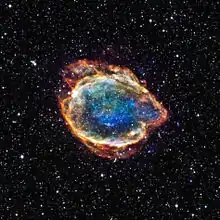GPM J1839−10
GPM J1839−10[1] is a potentially unique[2] ultra-long period magnetar[3][4] located about 15,000 light-years away from Earth in the Scutum constellation, in the Milky Way. It was discovered by a team of scientists at Curtin University using the Murchison Widefield Array.[5][6] Its unusual characteristics violate current theory and prompted a search of other radio telescope archives, including the Giant Metrewave Radio Telescope and the Very Large Array, which revealed evidence of the object dating back to 1988.[5] The signature of the object went unnoticed because scientists did not know to look for its unusual behavior.[5]
The current understanding of neutron stars is that below a certain rate of rotation, called "the death line", they cease emissions. Uniquely, not only does GPM J1839−10 have an extremely slow rotation of approximately twenty-two minutes, it emits bursts of radio waves lasting up to five minutes, for which there is currently no generally accepted explanation.[5][4][6][7][8]
Further reading
- P. Beniamini; Z. Wadiasingh; B. D. Metzger (2020). "Periodicity in recurrent fast radio bursts and the origin of ultralong period magnetars". Monthly Notices of the Royal Astronomical Society (published 23 June 2020). 496 (3): 3390–3401. doi:10.1093/mnras/staa1783.
- P. Beniamini; Z. Wadiasingh; J. Hare; K. M. Rajwade; G. Younes; A. J. van der Horst (2023). "Evidence for an abundant old population of Galactic ultra-long period magnetars and implications for fast radio bursts". Monthly Notices of the Royal Astronomical Society (published 20 January 2023). 520 (2): 1872–1894. arXiv:2210.09323. doi:10.1093/mnras/stad208.
- N. Hurley-Walker; X. Zhang; A. Bahramian; S. J. McSweeney; T. N. O’Doherty; P. J. Hancock; J. S. Morgan; G. E. Anderson; G. H. Heald; T. J. Galvin (27 January 2022). "A radio transient with unusually slow periodic emission". Nature (published 26 January 2022). 601 (601): 526–530. Bibcode:2022Natur.601..526H. doi:10.1038/s41586-021-04272-x. PMID 35082416. S2CID 246296294. Not open access.
- Ronchi, Michele; Rea, Nanda; Graber, Vanessa; Hurley-Walker, Natasha (27 January 2022). "Long-period Pulsars as Evidence of Supernova Fallback Accretion". The Astrophysical Journal. 934 (2): 184. arXiv:2201.11704. Bibcode:2022ApJ...934..184R. doi:10.3847/1538-4357/ac7cec. S2CID 250868925.
References
- N. Hurley-Walker; N. Rea; S. J. McSweeney (19 July 2023). "A long-period radio transient active for three decades". Nature. 619 (619): 487–490. doi:10.1038/s41586-023-06202-5. PMID 37468588. S2CID 259977730.
- Timmer, John (19 July 2023). "Something in space has been lighting up every 20 minutes since 1988". Ars Technica.
- P. Beniamini; Z. Wadiasingh; B. D. Metzger (2020). "Periodicity in recurrent fast radio bursts and the origin of ultralong period magnetars". Monthly Notices of the Royal Astronomical Society (published 23 June 2020). 496 (496): 3390–3401. doi:10.1093/mnras/staa1783.
- P. Beniamini; Z. Wadiasingh; J. Hare; K. M. Rajwade; G. Younes; A. J. van der Horst (2023). "Evidence for an abundant old population of Galactic ultra-long period magnetars and implications for fast radio bursts". Monthly Notices of the Royal Astronomical Society (published 20 January 2023). 520 (2): 1872–1894. arXiv:2210.09323. doi:10.1093/mnras/stad208.
- Strickland, Ashley (20 July 2023). "Unusual type of stellar object discovered beaming out radio waves". CNN. Retrieved 22 July 2023.
- "Hiding in plain sight, astronomers find new type of stellar object". International Centre for Radio Astronomy Research. 19 July 2023.
- "Bizarre 'slow' neutron star challenges our theories about dead stars". Space.com. 19 July 2023.
- "NRL Astronomers Track New Stellar Phenomenon" (Press release). 19 July 2023.

